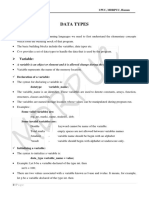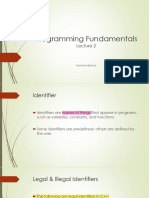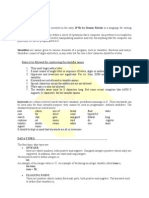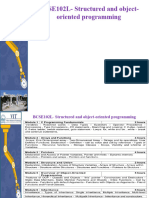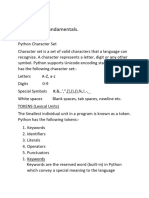Lesson 2
Uploaded by
Fang Shi XiangLesson 2
Uploaded by
Fang Shi XiangCSC1101 PLF Problem Solving Concepts for the Computer
Lesson Two: Problem Solving Concepts for the Computer
Objectives
1. Differentiate between the basic data types of variables and
constants, which include character, numeric and logical data types.
2. Set up and evaluate expressions and equations using variables,
constants, operators and the hierarchy of operations.
Introduction
Problems that can be solved on computers generally consist of only three:
1. Computational, problems involving some kind of mathematical
processing.
2. Logical, problems involving relational or logical processing, the
kinds of processing used in decision making on the computer; and
3. Repetitive, problems involving repeating a set of mathematical
and/or logical instructions.
The computer uses constants and variables to solve problems. They are
data used in processing.
Variables
♦ A named memory location in the computer that given a value that can be
changed any time during the processing of the program.
♦ Computer sets up a specific memory location to hold the value of each variable
name that found in a program.
♦ Variables can be any data type (few types of data)
♦ For any variables use in a program, should assign a name (called variable name
Prepared By Chong Page 1 of 10
CSC1101 PLF Problem Solving Concepts for the Computer
– user defined) and MUST define a data type (the type of data this variable can
hold).
♦ For example,
• value of age (variable name: age, data type – integer)
• value of cash price (variable name: price, data type – real)
• value of city code (variable name: city_code, data type – string).
Constants
♦ It is a value that is a specific alphabetical and/or numeric value that are never
changes during the processing of all the instructions in a solution.
♦ Constant can be any type of data – numeric, alphabetical or special symbols.
♦ The constant is a given location in memory and a name.
♦ For any constants use in a program, should assign a name (called constant name
– user defined) and MUST define a data type (the type of data this variable can
hold).
♦ During the execution of the program, this constant is given a value and then is
referred by its name and the value is never changed during the execution of the
program.
♦ For example, to calculate payroll for a company, constant can be the name of the
company.
Rules for Naming and Using Variable/Constant name
• Do not use reserved word/keyword as variable/constant name.
• Do not use spaces in a variable/constant name, i.e.HOURS WORKED. (if a
space is needed, use the underscore, i.e. HOURS_WORKED)
• Do not use a dash or any other symbols in a variable/constant name, except
underscore is allowed in a variable/constant name.
• A variable/constant name can come from a combination of letters and numbers,
Prepared By Chong Page 2 of 10
CSC1101 PLF Problem Solving Concepts for the Computer
but letter must come first in the name.
Extra Rules:
• Variable/constant must be named according to what they represent (a meaningful
variable/constant), i.e. HOURS for hours worked.
• Be consistent when using upper- and lowercase characters. In some languages
HOURS is a different variable name than Hours.
• Variable name that used to represent a data item should be used consistently
throughout the program where the data item is used. For example, you may not
use HRS or HOURSWORKED to represent the same data item.
Example: Input an integer number from the keyboard
Good variable name : Number
Poor variable name : A, N,
Data Type Groups
♦ The kind of data of a variable or a constant. The three basic data types are
numerical, character and logical.
Numerical data type – Integer and Real
♦ Includes all types of numbers and only can be used in calculations.
♦ It can be integers or real number.
♦ Integers are whole numbers and they can be represented positive or negative
value. I.e., -5, 89.
♦ Real numbers are floating numbers and can be expressed in scientific notation.
2.3E5 is the same number as 2.3 X 105 = 2300000. E stands for time 10 to the
power of.
Prepared By Chong Page 3 of 10
CSC1101 PLF Problem Solving Concepts for the Computer
Examples:
Variable Name Data Data type
Age 16 Integer
Salary 100.00 Real
Time 12.10 Real
Character data type – Character & String
♦ Sometimes known as alphanumeric data.
♦ Consists of all digit numbers, letter and special characters available to the
computer – A, a, z, 4, %, and so forth – placed within quotation marks.
♦ Upper case letters are different from lower case letter.
♦ Characters cannot be used for calculations even if they consist of only numbers.
♦ When more than one character is put together is known as String, a collections
of characters.
♦ Character and string can be compared and arranged in alphabetical order.
For example,
‘B’ is larger than ‘A’, ‘B’ is placed after ‘A’.
‘C’ is larger than ‘B’, ‘C’ is placed after ‘B’.
‘Banana’ is larger than ‘Apple’, therefore ‘Banana’ is arranged after the
‘Apple’.
Examples:
Variable Name Data Data type
Name Mel String
Gibson
Gender F Character
Account A2563222 String
Number
Password Mom*/9 String
Prepared By Chong Page 4 of 10
CSC1101 PLF Problem Solving Concepts for the Computer
Post code 70300 String
Logical data type
♦ Consists of two pieces of data in the data set; TRUE/FALSE .
♦ Some languages accept yes, T and Y for TRUE, and no, F and N for FALSE.
♦ They are used in making yes-or-no decisions.
Examples:
Variable Name Data Data type
Marital Status Y/N Logical
Credit check Y/N Logical
ok
Rules for data type groups
♦ The data that define the value of a variable or constant will most commonly be
one of three data types.
♦ The programmer designated the data type during the programming process. The
computer then associates the variable name with the designated data type.
♦ Data type cannot be mixed. For an example string data cannot be placed in a
variable memory location that has been designated as numerical or vice versa.
♦ Each of the data type uses what is called data set.
o The numerical data uses the set of all base 10 numbers, the plus (+) sign, and
the negative sign (-);
o The character data type uses the set of all characters and;
o The logical data type uses the set of data consisting of the words TRUE and
FALSE. The use of any data outside the data set results in an error.
Prepared By Chong Page 5 of 10
CSC1101 PLF Problem Solving Concepts for the Computer
♦ Any numeric item that must be used in calculations resulting in a numeric result
must be designated as numerical data type. All other numbers should be
designated as character or character-string data type.
Operators
• Operators are used to process data and to tell the computer how to process data.
• Operators are the data connectors within expression and equations.
• Three types of operators are used in calculation and problem solving include:
1. Mathematical operators, (Refer to text book, page no.22, Table 2.5)
+ Addition MOD Modulus division
- Subtraction \ Integer division
* Multiplication ^ Power
/ Division
• Use to form an arithmetic expression, e.g. 4+9
2. Relational, (Refer to text book, page no.22, Table 2.5).
=, >, <, >=, <=, <>
• Use to form a condition, e.g. (8 <= 10)
3. Logical, (Refer to text book, page no.22 & 23, Table 2.5 & 2.6)
AND, OR, and NOT.
• Use to join more than TWO conditions together, e.g. (8<=10) AND
(4 >10)
• The operand and resultant are two concepts related to the operators.
• Operand is the data that the operator connects and process.
• Resultant is the answer that results after the operation is completed.
For example, 5 + 7 = 12
5 and 7 are the operand, + is the operator, 12 is the resultant.
Prepared By Chong Page 6 of 10
CSC1101 PLF Problem Solving Concepts for the Computer
• These mathematical, relational and logical operators have a hierarchy or
precedence, an order in which their operations take place.
(Refer to text book, page no.24, Table 2.7 Hierarchy of Operations)
• To reorder the normal processing sequence, the programmer uses parenthesis.
Expression and Equations
• An expression process data, the operand, through the use of operators.
• Example : to find the production of two numbers
A*B
• An equation stores the resultant of an expression in a memory location in the
computer through the equal(=) sign.
• Example : The resultant of the expression A * B would be stored in a memory
location called C
C = A * B { Known as assignment statement}
Setting up a mathematical equation
• Mathematical equation has to be the form of an assignment statement.
Examples:
Mathematical equation Assignment statement
A+B=C C=A+ B
Y + 3 = X(Z+5) Y = X * (Z + 5) - 3
Evaluating mathematical expression
A = 10 B =1
Operation Resultant
A+B 11
Prepared By Chong Page 7 of 10
CSC1101 PLF Problem Solving Concepts for the Computer
Setting up a relational expression
• A relational expression is used to make decisions.
In computer form
X is less than Y + 5 X<Y+5
Evaluating relational expression
X=5 Y=4
Operation Resultant
Y + 5 (4+5) 9
X < Y (5<9) TRUE
Setting up a logical expression
• Based on more than one TRUE or FALSE
Example 1: Student must have student card(SC)or Identification card (IC) in order
to sit for and exam
SC OR IC
Example 2: Student must have both student card(SC)and Identification card (IC) in
order to sit for and exam
SC AND IC
Evaluating a logical expression
Values : A = TRUE B = FALSE C = FALSE
Given : A OR B AND C OR B
Prepared By Chong Page 8 of 10
CSC1101 PLF Problem Solving Concepts for the Computer
TABLE OF LOGICAL OPERATORS RESULTANT – TRUTH TABLE
AND OR NOT
C1 C2 R C1 C2 R C R
T T T T T T T F
T F F T F T F T
F T F F T T
F F F F F F
Operation Resultant
1. B AND C (TRUE AND FALSE) FALSE
2. A OR resultant 1 (TRUE OR FALSE) TRUE
3. Resultant 2 OR B (TRUE OR FALSE) TRUE
Prepared By Chong Page 9 of 10
CSC1101 PLF Problem Solving Concepts for the Computer
Questions: Discussion in the Class.
Q1. Fill in the following table with the variable name and data type.
Data item Variable Name Data Type
a. Name of vendor company
b. Inventory item name
c. Inventory number
d. Quantity
e. Price
f. Address of company
g. Date last ordered
h. Reorder quantity
i. Obsolete item (yes/no)
Q2. Name the data type for each of the following constant.
1. 5.38
2. “87645”
3. TRUE
4. “A”
5. “New York”
6. 2.45E6
7. 458963.62
Q3. Evaluate the following equations, given the values A = 12, B = 3, C = 6, D = 2.
1. F = A + B/C – D ^ 2
2. F = (A + B)/C – D ^ 2
3. F = A + B/(C – D ^ 2)
4. F = (A + B) MOD C
5. F = (A + B)\D ^ 2
Q4.
Set up a logical expression for the following conditions. A company gives a bonus
at the end of each fiscal year. For an employee to get a bonus, the following must be
true.
a. The employee has been working at the company for more than six
months with no negative reports.
b. The employee has earned more than $5,000 during the fiscal year.
Prepared By Chong Page 10 of 10
You might also like
- 2,27 Concepts of Variables and OperatorsNo ratings yet2,27 Concepts of Variables and Operators36 pages
- CH2-Beginning Problem-Solving Concepts for the ComputerNo ratings yetCH2-Beginning Problem-Solving Concepts for the Computer62 pages
- Chapter-8 Data Types: A Variable Is An Object or Element and It Is Allowed Change During The Execution of The ProgramNo ratings yetChapter-8 Data Types: A Variable Is An Object or Element and It Is Allowed Change During The Execution of The Program6 pages
- CSC128 Chapter 2 - Basic Elements of Computer ProgramsNo ratings yetCSC128 Chapter 2 - Basic Elements of Computer Programs9 pages
- Csc121 - Topic 3 Algorithm Design For Sequence Control StructureNo ratings yetCsc121 - Topic 3 Algorithm Design For Sequence Control Structure37 pages
- Variables, Data Types, and Arithmetic Expressions: Dept. of Computer Science Faculty of Science and TechnologyNo ratings yetVariables, Data Types, and Arithmetic Expressions: Dept. of Computer Science Faculty of Science and Technology19 pages
- Lecture-02 Introduction To Java Programming: by Dr. Bharati MishraNo ratings yetLecture-02 Introduction To Java Programming: by Dr. Bharati Mishra30 pages
- Introduction To C++ Programming LanguageNo ratings yetIntroduction To C++ Programming Language47 pages
- 2-Introduction to Structured Programming - C language History and Introduction - Datatypes-Basic IO statements - Variables - Keywords - Expression evaluation using operator precedence-17-12-2024No ratings yet2-Introduction to Structured Programming - C language History and Introduction - Datatypes-Basic IO statements - Variables - Keywords - Expression evaluation using operator precedence-17-12-202442 pages
- Fall 23-24-Lecture 2 DataTypesOperatorsNo ratings yetFall 23-24-Lecture 2 DataTypesOperators22 pages
- Csc121- Topic 3 Algorithm Design for Sequence Control Structure (1)No ratings yetCsc121- Topic 3 Algorithm Design for Sequence Control Structure (1)30 pages
- Beginning Problem-Solving Concepts For The ComputerNo ratings yetBeginning Problem-Solving Concepts For The Computer69 pages
- WINSEM2023-24 BCSE102L TH VL2023240501145 2024-01-05 Reference-Material-INo ratings yetWINSEM2023-24 BCSE102L TH VL2023240501145 2024-01-05 Reference-Material-I42 pages
- CS201 Short Notes For Midterm Lec 1 To 23No ratings yetCS201 Short Notes For Midterm Lec 1 To 2316 pages
- Suguna Pip School, Coimbatore (A CBSE Affiliated SR - Sec.School) Informatics Practices Grade Xi Revision Term1 Worksheet - 2No ratings yetSuguna Pip School, Coimbatore (A CBSE Affiliated SR - Sec.School) Informatics Practices Grade Xi Revision Term1 Worksheet - 25 pages
- Python Programming Language A Crash Course To MastNo ratings yetPython Programming Language A Crash Course To Mast61 pages
- 04 - Lab08 - Supplement - ScopeOfVariables in PythonNo ratings yet04 - Lab08 - Supplement - ScopeOfVariables in Python7 pages
- Microsoft Office 365 Administration Inside Out (PDFDrive)No ratings yetMicrosoft Office 365 Administration Inside Out (PDFDrive)861 pages
- PPS GTU Study Material Presentations Unit-2 18122020041700AMNo ratings yetPPS GTU Study Material Presentations Unit-2 18122020041700AM35 pages
- C P Notes Submitted By: Dewanand Giri BSC - CSIT First Sem Sec A Roll:8 Submitted To: Prof - Mohan BhandariNo ratings yetC P Notes Submitted By: Dewanand Giri BSC - CSIT First Sem Sec A Roll:8 Submitted To: Prof - Mohan Bhandari27 pages
- Python Programming Unit - I: History of PythonNo ratings yetPython Programming Unit - I: History of Python18 pages
- CH2-Beginning Problem-Solving Concepts for the ComputerCH2-Beginning Problem-Solving Concepts for the Computer
- Chapter-8 Data Types: A Variable Is An Object or Element and It Is Allowed Change During The Execution of The ProgramChapter-8 Data Types: A Variable Is An Object or Element and It Is Allowed Change During The Execution of The Program
- CSC128 Chapter 2 - Basic Elements of Computer ProgramsCSC128 Chapter 2 - Basic Elements of Computer Programs
- Csc121 - Topic 3 Algorithm Design For Sequence Control StructureCsc121 - Topic 3 Algorithm Design For Sequence Control Structure
- Variables, Data Types, and Arithmetic Expressions: Dept. of Computer Science Faculty of Science and TechnologyVariables, Data Types, and Arithmetic Expressions: Dept. of Computer Science Faculty of Science and Technology
- Lecture-02 Introduction To Java Programming: by Dr. Bharati MishraLecture-02 Introduction To Java Programming: by Dr. Bharati Mishra
- 2-Introduction to Structured Programming - C language History and Introduction - Datatypes-Basic IO statements - Variables - Keywords - Expression evaluation using operator precedence-17-12-20242-Introduction to Structured Programming - C language History and Introduction - Datatypes-Basic IO statements - Variables - Keywords - Expression evaluation using operator precedence-17-12-2024
- Csc121- Topic 3 Algorithm Design for Sequence Control Structure (1)Csc121- Topic 3 Algorithm Design for Sequence Control Structure (1)
- Beginning Problem-Solving Concepts For The ComputerBeginning Problem-Solving Concepts For The Computer
- WINSEM2023-24 BCSE102L TH VL2023240501145 2024-01-05 Reference-Material-IWINSEM2023-24 BCSE102L TH VL2023240501145 2024-01-05 Reference-Material-I
- Suguna Pip School, Coimbatore (A CBSE Affiliated SR - Sec.School) Informatics Practices Grade Xi Revision Term1 Worksheet - 2Suguna Pip School, Coimbatore (A CBSE Affiliated SR - Sec.School) Informatics Practices Grade Xi Revision Term1 Worksheet - 2
- Python Programming Language A Crash Course To MastPython Programming Language A Crash Course To Mast
- 04 - Lab08 - Supplement - ScopeOfVariables in Python04 - Lab08 - Supplement - ScopeOfVariables in Python
- Microsoft Office 365 Administration Inside Out (PDFDrive)Microsoft Office 365 Administration Inside Out (PDFDrive)
- PPS GTU Study Material Presentations Unit-2 18122020041700AMPPS GTU Study Material Presentations Unit-2 18122020041700AM
- C P Notes Submitted By: Dewanand Giri BSC - CSIT First Sem Sec A Roll:8 Submitted To: Prof - Mohan BhandariC P Notes Submitted By: Dewanand Giri BSC - CSIT First Sem Sec A Roll:8 Submitted To: Prof - Mohan Bhandari












